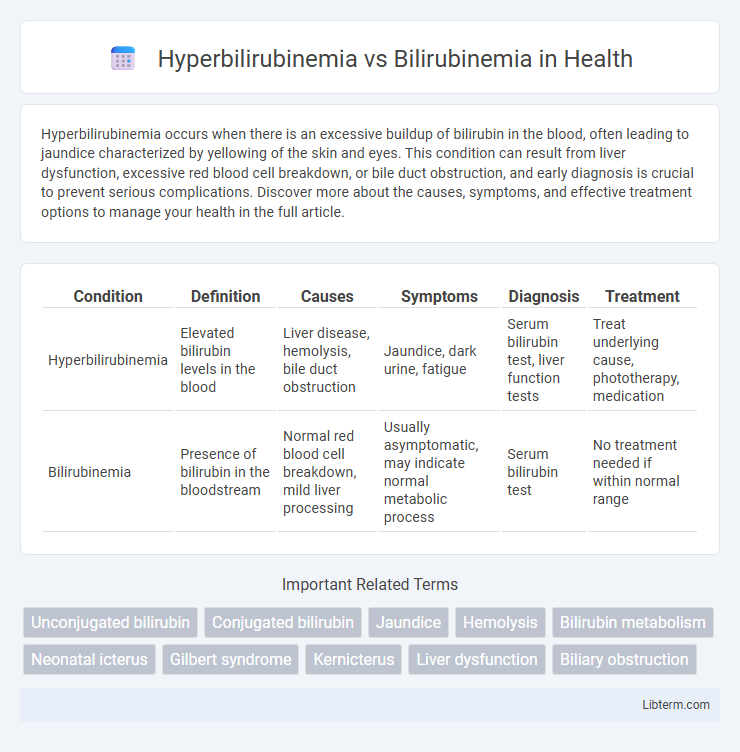Hyperbilirubinemia occurs when there is an excessive buildup of bilirubin in the blood, often leading to jaundice characterized by yellowing of the skin and eyes. This condition can result from liver dysfunction, excessive red blood cell breakdown, or bile duct obstruction, and early diagnosis is crucial to prevent serious complications. Discover more about the causes, symptoms, and effective treatment options to manage your health in the full article.
Table of Comparison
| Condition | Definition | Causes | Symptoms | Diagnosis | Treatment |
|---|---|---|---|---|---|
| Hyperbilirubinemia | Elevated bilirubin levels in the blood | Liver disease, hemolysis, bile duct obstruction | Jaundice, dark urine, fatigue | Serum bilirubin test, liver function tests | Treat underlying cause, phototherapy, medication |
| Bilirubinemia | Presence of bilirubin in the bloodstream | Normal red blood cell breakdown, mild liver processing | Usually asymptomatic, may indicate normal metabolic process | Serum bilirubin test | No treatment needed if within normal range |
Understanding Bilirubinemia: Definition and Basics
Bilirubinemia refers to the presence of bilirubin in the bloodstream, representing normal or slightly elevated levels depending on individual health status. Hyperbilirubinemia is a pathological condition characterized by abnormally high bilirubin concentrations that can lead to jaundice and indicate underlying liver dysfunction or hemolysis. Understanding bilirubinemia involves recognizing bilirubin's role as a byproduct of red blood cell breakdown and its importance in diagnosing hepatic and hematologic disorders.
What is Hyperbilirubinemia? Key Differences Explained
Hyperbilirubinemia is a medical condition characterized by an excessive concentration of bilirubin in the blood, typically exceeding 1.2 mg/dL, leading to jaundice and potential neurological damage if untreated. Bilirubinemia refers broadly to the presence of bilirubin in the bloodstream, which can be normal or elevated, but does not specify pathological levels. The key difference lies in the severity and clinical significance; hyperbilirubinemia denotes elevated bilirubin levels causing symptoms and requiring medical intervention, whereas bilirubinemia may simply indicate bilirubin presence without indicating abnormality.
Causes of Bilirubinemia in Adults and Neonates
Hyperbilirubinemia represents an elevated level of bilirubin in the blood, often causing jaundice, whereas bilirubinemia refers to the presence of bilirubin in the bloodstream irrespective of its concentration. In adults, causes of bilirubinemia include hemolytic anemia, liver diseases such as hepatitis or cirrhosis, and bile duct obstruction from gallstones or tumors. Neonatal bilirubinemia primarily arises from physiological immaturity of hepatic enzymes, increased red blood cell turnover, or hemolytic disease of the newborn due to blood group incompatibility.
Clinical Manifestations: Comparing Symptoms
Hyperbilirubinemia is characterized by elevated levels of bilirubin in the blood, leading to clinical manifestations such as jaundice, dark urine, and pale stools. Bilirubinemia refers more generally to the presence of bilirubin in the bloodstream but does not specify abnormal elevation or clinical symptoms. The key differentiator in clinical presentation is that hyperbilirubinemia often results in visible symptoms, whereas bilirubinemia may be asymptomatic depending on bilirubin concentration and underlying conditions.
Diagnostic Approaches: Bilirubinemia vs Hyperbilirubinemia
Diagnostic approaches for bilirubinemia involve measuring total and direct bilirubin concentrations in blood to determine normal or elevated levels. In hyperbilirubinemia, elevated serum bilirubin--typically above 1.2 mg/dL--requires further evaluation through liver function tests, imaging studies, and assessment of hemolysis or biliary obstruction. Differentiating unconjugated from conjugated hyperbilirubinemia is crucial for targeted diagnosis and management.
Risk Factors and Predisposing Conditions
Hyperbilirubinemia, characterized by elevated bilirubin levels exceeding 1 mg/dL in adults, often results from liver dysfunction, hemolytic anemia, or bile duct obstruction. Bilirubinemia broadly refers to the presence of bilirubin in the blood, with risk factors including genetic disorders like Gilbert's syndrome and metabolic conditions affecting bilirubin conjugation. Predisposing conditions for hyperbilirubinemia center on impaired hepatic processing, neonatal jaundice, and chronic liver diseases such as hepatitis or cirrhosis, distinguishing it from benign bilirubinemia cases.
Complications Associated with Elevated Bilirubin
Hyperbilirubinemia is characterized by excessively high levels of bilirubin in the blood, significantly increasing the risk of complications such as kernicterus, a type of brain damage resulting from bilirubin toxicity. Bilirubinemia, the presence of bilirubin in the blood, can be physiological or pathological, but elevated levels beyond the normal range often indicate liver dysfunction or hemolytic disorders. Unmanaged hyperbilirubinemia may lead to jaundice, neurological impairments, and in severe cases, chronic bilirubin encephalopathy.
Management Strategies for Both Conditions
Management of hyperbilirubinemia primarily involves identifying and treating the underlying cause, such as hemolysis, liver dysfunction, or bile duct obstruction, with interventions including phototherapy for neonatal cases and medications like ursodeoxycholic acid in cholestatic liver disease. Bilirubinemia, often a transient or mild elevation of bilirubin, may require only supportive care and monitoring unless associated with pathological conditions necessitating targeted therapies. Effective management depends on accurate diagnosis through serum bilirubin fractionation and liver function tests to guide appropriate clinical interventions.
Prevention and Prognosis: Key Considerations
Hyperbilirubinemia, characterized by elevated bilirubin levels in the blood, requires proactive monitoring and management to prevent complications such as kernicterus, whereas bilirubinemia refers simply to the presence of bilirubin without specifying abnormal levels. Preventive strategies for hyperbilirubinemia include early detection through neonatal screening, phototherapy, and addressing underlying causes like hemolysis or liver dysfunction. Prognosis depends on timely intervention, with untreated hyperbilirubinemia potentially leading to irreversible neurological damage, while normal bilirubinemia typically indicates healthy bilirubin metabolism.
Frequently Asked Questions about Bilirubin Disorders
Hyperbilirubinemia refers to an elevated level of bilirubin in the blood, commonly causing jaundice, while bilirubinemia is a broader term indicating the presence of bilirubin in the bloodstream without specifying abnormal levels. Frequently asked questions about bilirubin disorders often address causes such as liver dysfunction, hemolysis, and genetic conditions like Gilbert's syndrome. Treatment options and diagnostic methods, including blood tests measuring total and direct bilirubin levels, are also common concerns for patients and healthcare providers.
Hyperbilirubinemia Infographic

 libterm.com
libterm.com